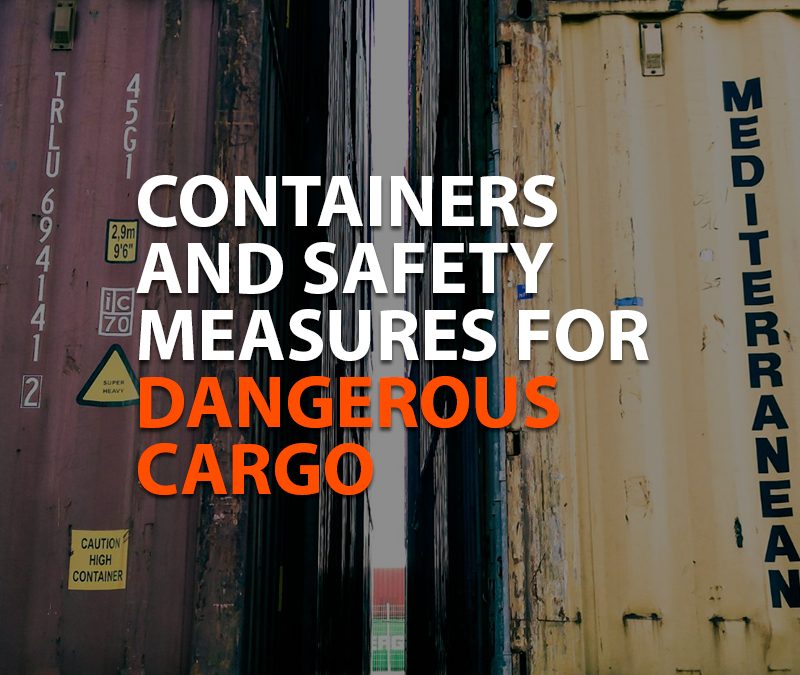The transport of dangerous goods by ship is highly regulated to ensure safety at sea and in ports. Different types of containers and security measures are employed depending on the class of the dangerous goods.
Security Measures for dangerous cargo
- Labeling and Placarding: Containers must be clearly labeled with the appropriate hazard class symbols and handling labels to indicate the nature of the danger.
- Stowage and Segregation: Different classes of dangerous goods must be stowed and segregated according to their chemical properties to prevent adverse reactions in case of spillage or leakage.
- Damage Control Plans: Ships must have plans and equipment for dealing with spills, fires, and leaks of hazardous substances, including containment systems and specialized firefighting equipment.
- Training and Documentation: Crew members handling dangerous goods must undergo specialized training. Detailed transport documents must accompany the shipment, specifying the nature of the goods and the safety measures to be followed.
- Emergency Preparedness: Ships must be equipped with emergency response plans tailored to the types of dangerous goods being carried. This includes equipment and protocols for containment, evacuation, and coordination with coastal authorities.
- Security Protocols: Access to hazardous materials during transit is strictly controlled, and all containers are sealed with tamper-evident seals to prevent unauthorized access.
Dangerous cargo signage
There are 9 main classes of dangerous cargo each with its correspondent signage:
1. Explosives

- Containers: Specialized containers that are robust and equipped to handle shocks.
- Security Measures: Strict segregation from other cargo, especially flammables; specific stowage instructions to minimize the risk of accidental detonation.
2. Gases

- Containers: Tank containers designed for high pressure for compressed and liquefied gases.
- Security Measures: Proper ventilation, secure stowage to prevent movement, and regular checks for leaks.
3. Flammable Liquids

- Containers: Tank containers with appropriate materials to resist corrosion and leaks.
- Security Measures: Segregation from oxidizing agents, ignition sources, and equipped with spill containment measures.
4.Flammable Solids

- Containers: Ventilated containers for substances that may release flammable gases.
- Security Measures: Isolation from water sources and other reactive substances; equipped with fire suppression tools.
5. Oxidizing Substances and Organic Peroxides


- Containers: Special containers that can prevent contamination and withstand reactive chemicals.
- Security Measures: Separation from flammables, detailed emergency plans for spills, and special firefighting procedures.
6. Toxic and Infectious Substances


- Containers: Leak-proof containers for toxic materials; special packaging for infectious substances to prevent biohazard risk.
- Security Measures: Strict controls to prevent accidental exposure, and emergency decontamination equipment on board.
7. Radioactive Material

- Containers: Special lead-lined containers to shield radiation.
- Security Measures: Detailed stowage planning to minimize exposure, continuous radiation monitoring, and strict access control.
8. Corrosive Substances

- Containers: Corrosion-resistant tank containers.
- Security Measures: Segregation from metals and organics, robust spill containment systems, and emergency neutralization agents available.
9. Miscellaneous Dangerous Goods

- Containers: Varies depending on the specific nature of the goods but generally includes well-sealed and durable containers.
- Security Measures: Proper labeling and stowage according to the specific risks posed by the materials, with general emergency plans tailored to possible risks.
For each class, the International Maritime Dangerous Goods (IMDG) Code specifies these and other necessary precautions, ensuring safety during the transport of dangerous goods by sea. This includes careful planning of the ship’s cargo plan to avoid dangerous interactions and ensure stability and safety at sea.






